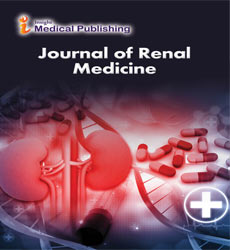High-Protein Diets and Their Effects on Glomerular Function Implications for Chronic Kidney Disease
Zhang Lin*
Department of Nephrology, Shengjing Hospital of China Medical University, Shenyang, China
- *Corresponding Author:
- Zhang Lin
Department of Nephrology, Shengjing Hospital of China Medical University, Shenyang,
China,
E-mail: lin@china.com
Received date: June 14, 2024, Manuscript No. IPJRM-24-19501; Editor assigned date: June 18, 2024, PreQC No. IPJRM-24-19501 (PQ); Reviewed date: July 02, 2024, QC No. IPJRM-24-19501; Revised date: July 09, 2024, Manuscript No. IPJRM-24-19501 (R); Published date: July 16, 2024, DOI: 10.36648/ipjrm.7.4.34
Citation: Lin Z (2024) High-Protein Diets and Their Effects on Glomerular Function Implications for Chronic Kidney Disease. J Ren Med Vol.7 No. 4: 34.
Description
A progressive condition, Chronic Kidney Disease (CKD) is characterized by alterations in the kidney's structure and function due to a variety of factors. The global incidence of nephropathy has been rising annually in recent years. Around 10% of adults worldwide suffer from some form of chronic kidney disease, making it the third most common condition. The worldwide weight of persistent kidney sickness is huge. killer after cancer and heart disease. There are many reasons for ongoing kidney illness, including those that are normal and all around contemplated, like diabetes, glomerulonephritis and cystic kidney infection, yet the etiology of constant kidney sickness isn't completely perceived. Serum BUN and SCr levels will rise as a result of a high-protein diet, which will cause moderate connective tissue hyperplasia, moderate fibrosis and moderate renal tubule and collecting duct atrophy. We accept that Inonotus hispidus can possibly turn into another sort of protected and powerful utilitarian nourishment for the therapy of constant kidney illness.
Treatment of chronic kidney disease
Which may put off necessary treatment or prevention until it reaches End-Stage Kidney Disease (ESKD). Moreover, diminished kidney capability additionally improves the probability of creating cardiovascular sickness and different issues, prompting higher death rates and decreased personal satisfaction. Since CKD does not have a cure at this time, it is important to find new ways to prevent it and reduce the overall burden of the disease. Fragility, characterized as an aggregate of diminished physiological saves and decreased capacity to answer stressors, has been connected to a scope of unfriendly results. Due to the similarities between frailty and CKD, including aging, decreased PA, weak handgrip strength and a sluggish walking pace, new evidence suggests a possible link. In fact, inactivity and decreased handgrip strength, both of which are signs of skeletal muscle dysfunction, may increase inflammation and insulin resistance, two major factors in kidney dysfunction. Past examinations have shown that slightness is high predominant and is related with expanded dangers of hospitalization, falls, ESKD, and mortality in patients with CKD. In adults with prediabetes, physical frailty was linked to a higher risk of CKD, according to a recent study. However, there is insufficient evidence of a longitudinal association between the risk of CKD in the general population and physical frailty.
Ecological elements of CKD
Notwithstanding ecological elements, hereditary variables can likewise add to the improvement of CKD. The hereditary Genetic Risk Score (GRS), which incorporates an improved on score of every allele's effect on sickness risk from a, will be a typical technique for assessing hereditary gamble for infections large number of common variants, most of which are Single-Nucleotide Polymorphisms (SNPs). While previous research has examined the ways in which CKD-GRS modifies the associations between non-genetic factors and CKD risk, the possibility of frailty and CKD-GRS interfering with the development of CKD has not been investigated. Subsequently, in the present planned review, we analyzed the longitudinal relationship between a variation of the Broiled's feebleness aggregate grouping and the gamble of CKD among moderately aged and more seasoned grown-ups from the UK Biobank. Moreover, we surveyed whether this affiliation varied by the hereditary inclination (still up in the air by GRS) by testing quality fragility association. Chronic kidney disease is more prevalent in obese, diabetic and hypertensive patients with high incomes, and one of the main reasons for this is one's eating habits. A seemingly healthy diet in High Protein (HP), in addition to a diet high in sugar and salt, contributes to chronic kidney damage. At the moment, an increasing number of dieters favor the HP diet. Concern about HP diets' potential negative effects on health has existed for decades, despite their increasing prominence in the media and local supermarkets. Gliomular hypertension, which can result from eating too much protein, can damage the glomeruli and cause albuminuria. Early experiments demonstrated that a diet high in protein. Studies have shown that glomerular hyper filtration related with a high-protein diet might build the gamble of new CKD or may speed up the advancement of previous CKD.
Open Access Journals
- Aquaculture & Veterinary Science
- Chemistry & Chemical Sciences
- Clinical Sciences
- Engineering
- General Science
- Genetics & Molecular Biology
- Health Care & Nursing
- Immunology & Microbiology
- Materials Science
- Mathematics & Physics
- Medical Sciences
- Neurology & Psychiatry
- Oncology & Cancer Science
- Pharmaceutical Sciences
